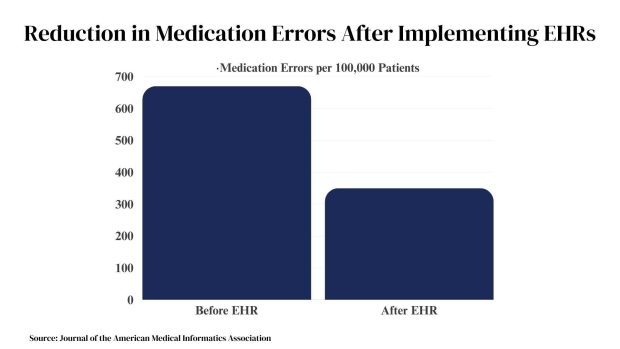Electronic records are transforming healthcare. By digitally organizing patient medical history across providers, EHRs, and EMRs give doctors complete pictures of their health. This leads to better care through enhanced coordination, safety, and accuracy. Let’s explore the exciting ways they are transforming medicine for the better. Longevity Live Paid Content.
EHRs Give Doctors the Complete Picture of Patient Health
EHRs are much more than just digital versions of old paper medical charts. They create one centralized place for providers to see a patient’s important health information. This fuller view helps doctors make smarter choices about care. It also allows them to coordinate a patient’s care between different offices and specialists smoothly.
Before EHRs existed, key health details for a patient were often scattered across different paper files, folders, and locations. Since everything was separate, it was super hard for doctors to get the complete health story in one place. EHRs wonderfully fix the issue. They gather medical data from across the entire healthcare ecosystem and store it securely in one comprehensive digital profile.
Having everything in one spot makes a huge difference. When doctors have access to all the data on a patient’s medical history, medications, allergies, past treatments, recent test results, and more, they can provide way better care. The difference between EMR and EHR is that EMRs focus on digital versions of patient charts in one practice or hospital, while EHRs share data across providers.
More Patient Information Enables Better Medical Decision Making
EHRs give doctors an in-depth picture of a patient’s total health over time. What exactly can EHRs include? Here are some examples:
- The patient’s full medical history and all the health conditions they’ve had
- Any chronic diseases or illnesses the patient is managing
- All prescription and over-the-counter medications the patient is taking
- Known medication allergies and reactions
- Vaccination records and dates
- Results from medical tests like bloodwork, x-rays, MRIs, and more
- Vital signs tracked during doctor visits
- Notes and reports from all providers involved in the patient’s care
Having all this vital information readily available in one place lets providers do really important things, such as:
- Quickly identify any past or current health issues that might impact the patient’s care right now
- Spot potential problems like medication errors, interactions, or overlaps that could be dangerous
- Develop more personalized treatment plans tailored specifically to that patient
- Avoid unnecessary extra tests and procedures since they can see what’s already been done
- See clearly what has and hasn’t worked for this patient before when caring for them
On top of all that, many EHR systems have special built-in alerts and reminders. This can flag potential issues or gaps in care right at the point of the patient visit. This helps doctors make the most accurate diagnoses, choose the safest prescriptions, and prevent medical complications.
EHRs Help Healthcare Teams Work Smarter and More Efficiently
EHRs provide tools that save healthcare teams lots of time and frustration. This will help streamline and smooth out the care process. Here are some of the great benefits:
- Increased efficiency – No more waiting around for someone to pull up paper files from some backroom archive. All the health data is right there in the EHR. Plus, test, and lab results flow directly into the record as soon as they’re available. Prescriptions can be electronically sent straight to the pharmacy. No faxes or paper scripts are needed.
- Better coordination – All members of the care team can securely access the EHR at the same time from different locations. This makes it easy for doctors, nurses, and specialists to collaborate on the patient’s care plan. They’re all on the same page.
- Big cost savings – Healthcare offices cut down a lot on paperwork, printing, faxing, and other administrative tasks with EHRs. Doctors can spend less time handwriting notes and charting. This frees up their schedule to see more patients. One major study found that transcription costs dropped by 50% after healthcare providers started using EHR systems.
- Enhanced revenue cycle – EHRs allow providers to use automated billing systems. This saves so much time in processing insurance claims and following up on payments. It helps them maximize reimbursement and get paid faster.
EHRs Are Helping Drive Major Improvements in Health Outcomes
EHRs are doing awesome things to improve patient health results:
- Preventing illness – EHRs help track gaps in preventive care for patients. They prompt doctors when it’s time to schedule recommended health screenings, vaccines, or tests. This improves preventive medicine.
- Assisting diagnosis – Because EHRs compile such an extensive medical history in one centralized place, doctors can more quickly spot health patterns and connections. This allows them to accurately diagnose conditions earlier.
- Improving safety – EHR medication lists and alerts prevent dangerous mix-ups or interactions. According to a 2013 study published in the Journal of the American Medical Informatics Association, medication errors dropped by 48% after hospitals started using electronic health records (EHR) systems. It’s huge for keeping patients safe!

- Engaging patients – Patient portals connected to EHRs let patients access their records 24/7 from their phone or computer. People can view test results, track health progress, refill meds, message their doctors, and update their medical history. This gets patients way more involved in managing their care.
- Enhancing education – Many EHR programs integrate patient education materials that providers can print out or email. Sharing this content helps educate people about prevention, treatment, managing chronic conditions, and more. Promoting self-care skills benefits long-term health.
Overcoming Common Barriers and Challenges with EHR Implementation
Switching from paper to digital records is a big change for doctors’ offices. It takes time to get used to. Here are some common challenges that have come up:
- Costs – Buying software, hardware, and cybersecurity can be expensive, especially for smaller offices. The upfront costs seem high. Grants, financing options, and incentive programs can help lower these expenses.
- Training – Doctors, nurses, staff, and managers all need training on how to use the technology right. With training, workflow can be smooth and smooth. Investing in training helps get the most out of the system.
- Moving data – Moving all old paper patient files into a new digital system takes a lot of time and people. This must be done slowly and carefully to prevent errors or missing information. Depending on how many records an office has, this could take months.
- System integration – Unfortunately, some software systems don’t sync well with other key systems like pharmacy and insurance platforms yet. But technology is improving in this area fast. More integrated systems are coming.
With planning, budgeting, training, and patience, healthcare teams can overcome any bumps that pop up. The long-term benefits of smooth adoption are worth it.
FAQs
How exactly do electronic health records (EHRs) help doctors and patients?
- EHRs let doctors see all of a patient’s health information in one place. This helps them make faster, more accurate diagnoses.
- EHRs also reduce mistakes by showing problems like medical interactions.
- EHRs allow doctors to create better treatment plans tailored to each patient.
- Getting rid of paper records and manual work makes the whole healthcare process quicker and smoother.
What are some of the biggest challenges doctors and hospitals face when switching to EHRs? How can they prepare for these?
The main challenges are upfront costs, learning to use new technology, moving old records into the new system, and getting different tech systems to work together. Doctors can plan their budgets to cover training costs and new tech expenses. Taking the time to slowly transfer old records prevents major disruptions. Asking EHR companies about system integration helps them choose the right EHR. With good planning and training, the switch to EHRs can go pretty smoothly.
Conclusion
Numerous improvements in care coordination, patient safety, health outcomes, speed, accuracy, and patient engagement demonstrate that EHRs are genuinely transforming modern healthcare for the better. Overcoming expected growing pains along the way is doable. The outlook is very bright for EHR systems to keep moving healthcare forward and improving people’s lives through better care and connectivity. Health innovations are just getting started!
Who is the author?

Daniel Martin
Daniel Martin is a digital marketing professional with years of experience in the industry. He has a proven track record in building high-performance teams that produce engaging content enjoyed by millions of users.
Dani’s unique combination of creative and innovative thinking has helped him solve complex challenges for clients in a wide range of industries. When he’s not working, he enjoys photography and playing the carrom board.





![women [longevity live]](https://longevitylive.com/wp-content/uploads/2020/01/photo-of-women-walking-down-the-street-1116984-100x100.jpg)










